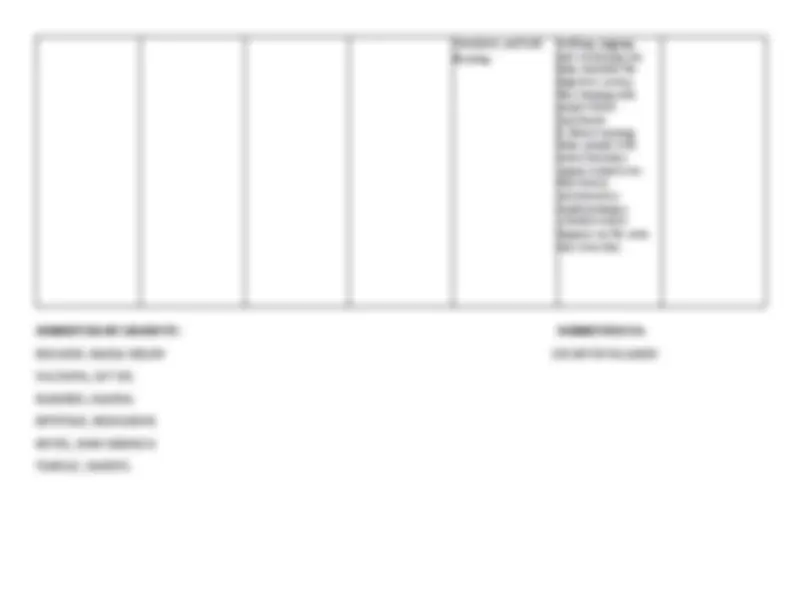Download NCP-CONSTIPATION-GROUP 6 and more Lab Reports Nursing in PDF only on Docsity!
PHINMA UNIVERSITY OF PANGASINAN
NURSING CARE PLAN ( CONSTIPATION )
ASSESSMENT DIAGNOSIS OUTCOME PLANNING INTERVENTION RATIONALE EVALUATION
Subjective Data:
The patient
complaints of not
having regular
bowel movement
and states that he
hasn’t defecated for
a week now. He
also claims that he’s
having difficulty
passing his stools
and when he does it
is very hard and
small.
Objective Data:
- Presence of
impaired mobility
- Release of unusual
acne and skin
breakouts
- Hypoactive bowel
sound
- Dry stools that are
difficult to pass
Patient VS are
follows
BP : 110 / 20 mmHg
RR : 22 bpm
PR : 118 bpm
Temp : 37 degrees C
Constipation related to insufficient fluid or fiber intake and poor eating habits as evidence by absence of stool. Expected Outcome:
- Within 3 - 4 days of receiving this diagnosis, the patient express that his defecated habit have been returned to its normal and usual condition.
- The patient continues to have well-formed bowel movements and not to experience difficulty when passing his/her stools by at all, and is successfully able to identify actions to take to prevent constipation in the future. Short Term: After 4 hours of nursing intervention, the client will establish or return to normal patterns of bowel functioning. Long Term : After 10 hours of nursing interventions, the patient's constipation will be relieved as evidenced by:
- Absence of abdominal distention
- Client will be able to defecate
- Demonstrate ROM exercise to relieve constipation
- Verbalize understanding about the interventions with regards to relieving constipation
- Determine stool color, consistency, frequency and amount.
- Increase dietary fiber intake.
- Encourage increase fluid intake of 2500 - 3000 ml/day within cardiac tolerance.
- Encourage fruits and vegetables, avoid processed foods or fast foods.
- Avoid large amounts of artificial fruit juices and sodas as it has large amount of sugar which can lead to constipation.
- Auscultate bowel sounds.
- Feel for palpable mass or tenderness 8 Encourage regular play and activity.
- Promote bowel training.
- Discuss use of stool softener, mild
- A diet high in fiber helps maintain bowel health and aids in softening the stools as well as laxatives like mild stimulants and bulks forming It works by absorbing water and adds bulk to stool, thus making it easier to pass.
- Sufficient fluid is vital to promote correct stool consistency
- Fruits and vegetables that are rich in fiber and other nutrients help with normal bowel movement and improve stool consistency. Foods that are high in fat like fast foods may cause or worsen constipation as well as foods that are high in sugar
- Decreased or absent bowel sounds often indicate constipation.
- Exercises and activities like
- The ease, regularity, and frequency of bowel motions should be evaluated.
- A favorable result would be if the patient reported decreased pain and discomfort when bowel movements.
- If a patient is using laxatives, it is important to check the patient's dosage and frequency to make sure the drug is working as intended and not having any negative side effects.
- If the patient is not responding well to the treatment approach, you might need to reevaluate the primary cause of constipation and adjust the treatment strategy. A specialist referral may be required in specific circumstances.
SUBMITTED BY GROUP IV: SUBMITTED TO:
ROSARIO, MARIA HELEN SIR KEVIN FAJARDO
SALDANA, JAY GIL
RAMIREZ, GIANNA
RETOTAR, JHONAROSE
REYES, JOHN HENRICK
TABUAC, DARRYL
stimulants, and bulk forming. walking, jogging, and swimming can help stimulate the digestive system, thus helping with proper bowel movement.
- Bowel training helps people with bowel disorders regain control over their bowel movement by implementing a schedule which happens on the same day every day.










